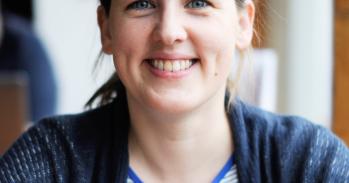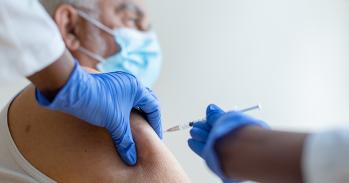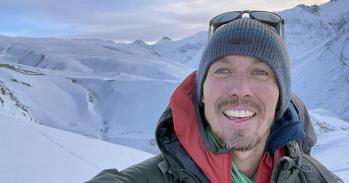
Professor Julia Gog is a mathematician who specialises in modelling the spread of infectious diseases, particularly pandemic influenza. For months, she and the other members of her research group in the Department of Applied Mathematics and Theoretical Physics have been modelling and mapping the spread of coronavirus and COVID-19.
Professor Julia Gog is a mathematician who specialises in modelling the spread of infectious diseases, particularly pandemic influenza. For months, she and the other members of her research group in the Department of Applied Mathematics and Theoretical Physics have been modelling and mapping the spread of coronavirus and COVID-19.
In the midst of the pandemic, she has been providing advice to the Government through SPI-M, the specialist pandemic modelling group that feeds into SAGE, the Scientific Advisory Group for Emergencies, as well as through Cambridge’s Centre for Science and Policy (CSaP).
In 2018, she and her team were behind the UK’s largest citizen science experiment in collaboration with the BBC, using location data from mobile phones to map how pandemic influenza might spread across the UK. The massive dataset that resulted from the experiment, the largest and most detailed of its kind, has been useful to teams working on the current pandemic.
"Public health experts have been saying for decades that when it comes to pandemic flu, it wasn’t a matter of if, it was a matter of when," Gog said. "And now that this coronavirus pandemic is here and things are changing every day, we’ve got to get information out there quickly, but making sure that it’s useful information that can help inform good policy."
With the earliest cases of COVID-19 in the UK, it was possible to perform contact tracing and shut down early chains of transmission. The data suggests that there wasn’t a single case that began the virus’ spread across the UK, but multiple cases, each with their own transmission chains.
It’s likely that cases arrived relatively early London due to its centrality in the nation and as much of the country’s transport infrastructure is built around getting people in and out of London. With many international imports of new cases, eventually the approach of contact tracing is overwhelmed and transmission takes hold within the UK, requiring the introduction of more severe overall social distancing measures to control transmission.
Once cases are rising exponentially, in order to contain the pandemic we must reduce the number of people that each contagious person infects. In disease dynamics, this reproduction ratio is called R. For any epidemic or pandemic to die out, in the absence of a vaccine, the effective R needs to be less than one: that is, if each contagious person infects less than one other person, then the number of new cases will slow and, eventually, stop. Current data suggests that the original reproduction ratio, R0, for coronavirus was between 1.5 and 3.5.
For modellers like Gog, knowing how and when people come into contact with other people helps determine R, and in turn helps develop a model of how a pandemic spreads.
The data from the BBC Pandemic project provides a highly useful source of data on how we most often come into contact with others. For those of working age, the workplace is the source of much person-to-person contact, so switching to remote working for those who can do so will reduce transmission between workplace colleagues. For those over 65, who are most at risk from severe illness due to COVID-19, most contact occurs outside the home, in places such as shops, restaurants and leisure activities, so shutting down these non-essential activities is also key to reducing R.
Earlier in the pandemic, there was criticism of the Government’s initial reluctance to close schools. However, Gog says that all the evidence suggests that school closures will only reduce transmission rates between 10 and 20 percent. Earlier models of the spread of seasonal ‘flu have looked at schoolchildren as key spreaders, but the behaviour of children, in particular teenagers, has changed a great deal in the past decade: teenagers now do much of their socialising online, and don’t so often gather in large groups as much as older generations did, a point that was confirmed by the BBC Pandemic data. In addition, it is unclear at the moment how much role children play in coronavirus transmission, whether they are as susceptible and infectious as adults.
"We have to adapt our models to account for the way that people are behaving now," said Gog. "Four weeks ago, a transmission reduction of ten or twenty percent might not have seemed like a lot. Additionally, children who were out of school while their parents were continuing to work might have gone to spend the day with their grandparents, putting them at risk. But right now, we’ll take any reduction you can get. The key thing now is to keep the number of critical cases as low as you can to reduce burden to a point that health systems can manage."
Every model has a degree of uncertainty, and for Gog, the biggest challenge in mapping how COVID-19 might continue to spread is that there has not been widescale testing in the UK. There is no ‘one true model’, and so epidemiological modellers have been modelling a range of scenarios and adapting as more data becomes available. In addition, there is a lag between the number of reported deaths and when those people became infected, further complicating the work of Gog and her colleagues.
"There are different ways this all plays out based on the information we have right now, and we have to model for different eventualities," said Gog. "It’s likely we won’t see very clearly the full effect of the lockdown measures until they have been in place for a few weeks."
Looking beyond the next few weeks, Gog says the information she and her colleagues around the country are desperate to have is information about what proportion of the population has been infected, via widescale antibody testing.
"Once we have that information, it will help us make better decisions about what to do next," said Gog. "If only a small proportion of the population has contracted the virus, then we could remain in lockdown for quite some time, whereas if a significant part of the population has already had it, then we can start thinking about how we get back to normal."
Further reading
Find out more about the mathematical modelling in How can maths fight a pandemic, Plus magazine's article featuring Professor Julia Gog. Plus is an online magazine introducing readers to the beauty and the practical applications of maths, which is part of the Millennium Mathematics Project at the University of Cambridge.
How you can support Cambridge's COVID-19 research effort
Donate to support COVID-19 research at Cambridge

The text in this work is licensed under a Creative Commons Attribution 4.0 International License. Images, including our videos, are Copyright ©University of Cambridge and licensors/contributors as identified. All rights reserved. We make our image and video content available in a number of ways – as here, on our main website under its Terms and conditions, and on a range of channels including social media that permit your use and sharing of our content under their respective Terms.




